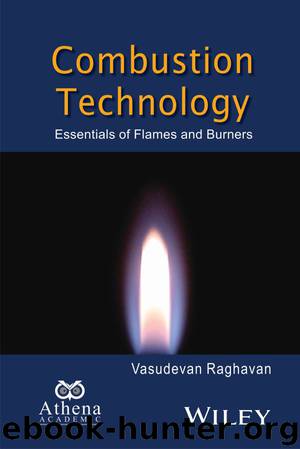Combustion Technology by Vasudevan Raghavan

Author:Vasudevan Raghavan [Raghavan, Vasudevan]
Language: eng
Format: epub
ISBN: 9781119241812
Publisher: John Wiley & Sons, Inc.
Published: 2016-07-15T03:23:23+00:00
4.2. Co-flow Burners
In order to improve the combustion characteristics of a simple jet diffusion flame, an air stream flowing through an annular area around the fuel jet is provided resulting in the so-called co-flow configuration. This enables an increased rate of transport of air to the flame over and above that due to natural entrainment of quiescent air from the atmosphere. Therefore, the length of the resultant flame in the co-flow burner is shorter than that of the jet diffusion flame for the same fuel flow rate. Characteristics of flames from different types of co-flow burners are discussed next.
Consider the co-flow burner shown in Fig. 4.2. The entrainment of atmospheric air is completely suppressed in this burner owing to the presence of the confining wall on the outer periphery of the oxidizer stream. For a given fuel flow rate, if the oxidizer flow rate is high enough, the resultant flame has a shape similar to that of a jet diffusion flame and is called an over-ventilated flame. If the oxidizer flow rate is less, then an under-ventilated flame, where the flame stretches towards the oxidizer stream, is seen. These flames were first analyzed by Burke and Schumann. From an under-ventilated flame, as the co-flow rate of oxidizer is increased, the flame transforms to an over ventilated flame and with a further increase in the oxidizer flow rate the flame extents are seen to decrease.
Download
This site does not store any files on its server. We only index and link to content provided by other sites. Please contact the content providers to delete copyright contents if any and email us, we'll remove relevant links or contents immediately.
| Fluid Dynamics | Thermodynamics |
The Complete Stick Figure Physics Tutorials by Allen Sarah(7336)
Secrets of Antigravity Propulsion: Tesla, UFOs, and Classified Aerospace Technology by Ph.D. Paul A. Laviolette(5332)
Thing Explainer by Randall Munroe(3909)
The River of Consciousness by Oliver Sacks(3572)
The Order of Time by Carlo Rovelli(3162)
How To by Randall Munroe(3074)
A Brief History of Time by Stephen Hawking(2991)
I Live in the Future & Here's How It Works by Nick Bilton(2959)
What If?: Serious Scientific Answers to Absurd Hypothetical Questions by Randall Munroe(2667)
The Great Unknown by Marcus du Sautoy(2662)
Midnight in Chernobyl by Adam Higginbotham(2515)
Blockchain: Ultimate Step By Step Guide To Understanding Blockchain Technology, Bitcoin Creation, and the future of Money (Novice to Expert) by Keizer Söze(2467)
Networks: An Introduction by Newman Mark(2382)
The Meaning of it All by Richard Feynman(2318)
Easy Electronics by Charles Platt(2308)
The Tao of Physics by Fritjof Capra(2247)
Midnight in Chernobyl: The Untold Story of the World's Greatest Nuclear Disaster by Adam Higginbotham(2195)
When by Daniel H Pink(2098)
Introducing Relativity by Bruce Bassett(2097)
